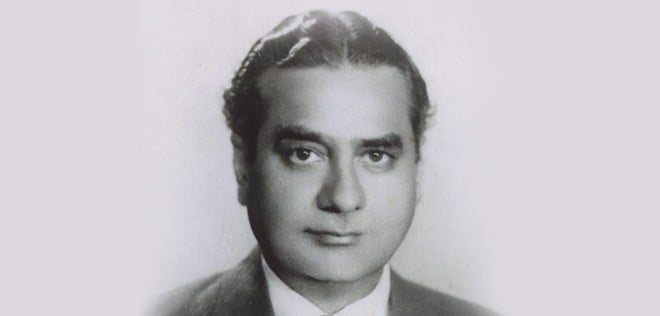

Modern Urdu novelist and short story writer Sadiq Hussain (1917-2005) had humble beginnings. He lost his father at the age of two, only to be raised by his devoted mother. He was the youngest of the seven children all of whom except his elder sister passed away during his lifetime. Being the only son he was forced to take charge of his life rather early.
Soon Hussain was writing short stories -- he was barely 10 years old at the time. He went on to study at Gordon College, Rawalpindi.
Sadiq Hussain knew that the creative writing he had started would take time to mature. He had the patience to wait as well as the will to continue. He wrote incessantly, only to realise, soon enough, that this was not a potential source of livelihood. Hence, he joined the Civil Services in the government of India, in Supply Department.
A few years later, Hussain was transferred in the department of Defence. During this period, he was based in Calcutta where he imbibed the rich culture of Bengal, its language and literature.
After the Partition of India, Hussain came to the then East Pakistan where he served the government of Pakistan in different capacities including that of a magistrate. He was in his mid-thirties when he decided to return to his first love -- writing -- printing initially in the literary journal Naqoosh, Lahore. His first published story, titled ‘Boofay’, took the local literary scene by the storm, winning Hussain accolades from all over. He was hailed as a fine short story writer of his time. Literary giants like Syed Viqar Azim and Editor Naqoosh Mohammad Tufail, both of whom later became his close friends, welcomed him with open arms. Maulana Salahuddin, Editor Adabi Dunya, even called him a lively addition to the dying genre of Urdu short story writing. And Professor Rashid Ahmed Siddiqi of Aligarh University reportedly said, "[Hussain] makes the reader feel he is reading a good story by a good man who is also a good artist."
In 1953, Sadiq Hussain was deputed as the first liaison officer for East and West Pakistan and he moved to Karachi. Two years later, he joined a prestigious British firm Black Wood Hodge and was transferred to Lahore. Later, while in Lahore, he joined a Pakistani firm led by Mr MA Yahya. It was with this man that Hussain remained associated till his death in 2005. Dr Jamil Jalibi, Dr Safdar Mehmood, Intizar Hussain, Laeeq Ahmed and Ibn-i-Insha were among his other close friends.
Sadiq Hussain produced very few short stories that, however, were good enough to earn him a place among the high-ranking contemporary writers of the time. He picked up real issues that plagued the underprivileged and presented them skilfully in his unique style. Reading his stories, one feels the writer has complete command over his theme and characters. His stories leave a deep imprint on the minds of the readers.
Hussain’s first published short story ‘Boofay’ touched everyone who read it. Here, he depicted the high society as he had found it in the Chittagong Club that was reserved for the Englishmen before the Partition but was now open to public. ‘Boofay’ revolves around an ordinary man named Hafeez who is penniless but has this strong fascination for the high society of the Club. When the Pakistan Women’s Association arranges a buffet at the Club, Hafeez also purchases the ticket which is priced at Rs5. His dream finally seems likely to be fulfilled. Sadiq Hussain’s description of the environment during and after the buffet makes the crux of the story. His impressions are so vivid that the reader instantly develops an affinity with the main character and his plight. The climax of the story is most heartfelt: suddenly, the atmosphere of the club comes to a halt. The buffet is over. Hafeez starts fishing for (any remaining) coins in his pockets. One, two, three… He is not sure if these will suffice to buy him the next day’s meals. The silence after the buffet dinner is deafening.
In Hussain’s short stories, the characters come from the lower strata of society. They symbolise the everyday dilemmas faced by the ‘real’ people. The heroes in these stories, then, are the unprivileged people who rise in the midst of the deep inequalities that exist in the society. His first anthology, titled Phoolon Ke Mahal, was published in 1963 by Naqoosh Press. It included his masterpiece ‘Pohonchian’ (A pair of gold bangles) and ‘Pathera’ (The brick maker).
The book was followed by Shehar Ander Shehar, which appeared in 1988, and Gulab Kai Ansoo (2008). The latter collection, in particular, shows a studied evolution of the downtrodden into those who are able to stand up to their suppressors.
Out of the three collections of his short stories, Hussain was able to print only two in his lifetime. Post-humously, his stories were printed in Afsanay -- Sadiq Hussain by Book Home Publishers in 2012.
Sadiq Hussain also penned two novels -- the one in Urdu is titled Naya Savera and the other, in English, is titled The Sun Will Rise Tomorrow. The Urdu novel saw the light of the day only as recently as in 2013. As for the English novel, Hussain lost its final draft.